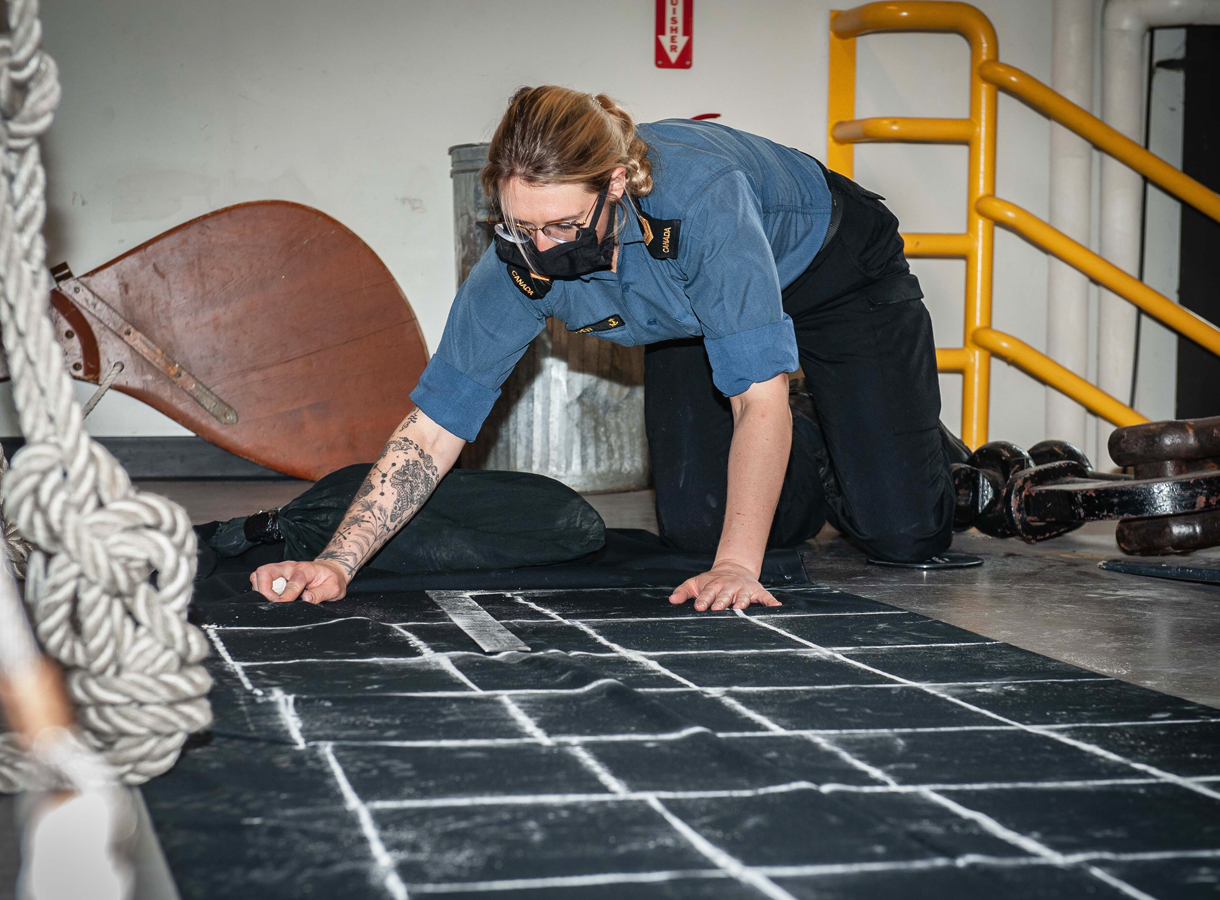Preparing for the new normal
By Lookout on Jun 08, 2020 with Comments 0

Leading Seaman Brittany Oliver traces patterns to be used in the creation of non-medical face coverings for Canadian Armed Forces members to wear in the wake of COVID-19. Photo by MCpl Carbe Orellana, MARPAC Imaging Services
Peter Mallett, Staff Writer ~
To prepare military and civilian staff for a safe return to work, base units and ships are fabricating non-medical face coverings.
A joint directive – DND/CAF COVID-19 Public Health Measures and Personal Protection – released by the Chief of the Defence Staff, Deputy Minister of Defence, and DND details guidelines for the wearing of face coverings in order to reduce the risk of transmission of infectious viruses. It states that face coverings will be worn by all Department of National Defence staff who cannot maintain the required two metres of physical distancing in the workplace.
In order to minimize the risks of COVID-19 transmission within the DND workplace, the Deputy Minister and Chief of Defence Staff has authorized the procurement of materials for non-medical face coverings at a national level, says Cdr Katherine Kincaid, logistics officer for Maritime Forces Pacific.
“Globally, there is a shortage of disposable face coverings. Therefore, the production of cloth masks by our local units will allow Defence Team members authorized to report to work to meet the criteria of public health measures outlined in this joint directive,” said Cdr Kinkaid.
Multiple teams at Maritime Forces Pacific and CFB Esquimalt are currently manufacturing them – Fleet Maintenance Facility Cape Breton (FMF CB), Naval Fleet School Pacific, and boatswains in HMC Ships Vancouver, Winnipeg and Ottawa have been assigned the task.
Fabrication teams have received assembly instructions through an internal DND memo. Face coverings are to be conservative in nature and should not detract or discredit the military uniform. At CFB Esquimalt, most face coverings will be fabricated with black coloured fabric due to available supplies.
Face coverings have an outer layer made of 50 percent cotton and nylon, an inner filament layer of 100 percent cotton, aluminium or copper wire, a metal nose piece, and an elastic band or cotton tie to secure the mask.
Naval Fleet School (Pacific) staff have created an assembly style manufacturing team of seven. Two people cut material, one person outlines the areas to be stitched, three people sew the required stitches, and one acts as manager of the operation. Together they produce 110 masks a day, but that number is set to rise as efficiencies increase.
At FMF CB, a team of over 100 employees from multiple shops have made over 2,900 non-medical face coverings since their work began on the project in early April. This includes 655 face coverings for FMF personnel and 2,286 put into the national system. They are producing the masks both on site and by employees and volunteers who are working from home. Washing and packaging the masks is required before they are put into the supply system.
Overall, this project has become a morale booster for the unit says Ian Baxter, FMF CB Group 2 Manager. He says the work has instilled a renewed sense of pride within his workforce. Steve Ringma, Group 2 Work Centre Manager, adds the level of unity is impressive in very challenging times.
“It is great to see everyone at FMF and across the base pulling together to support this project,” said Ringma. “They all understand the importance of this for the CAF and FMF get to get back any sense of a normal posture.”
Lt(N) Tony Boston is the deck officer in charge of manufacturing the face coverings aboard HMCS Winnipeg. They have produced 570 face coverings for sailor to use aboard the ship. Now, he and his crew are producing them for base use.
“I and other members of the ship’s company are happy to be given this opportunity. Later in 2020, we are looking forward to the prospect of Winnipeg returning to sea and making these masks is one way we can achieve this goal safely.”
––––
Filed Under: Top Stories
About the Author:





